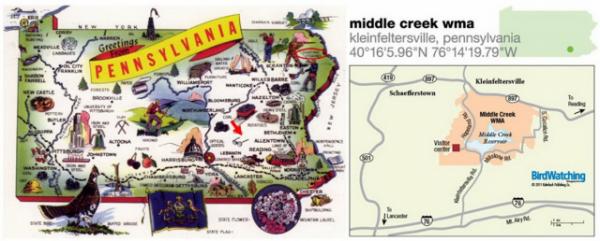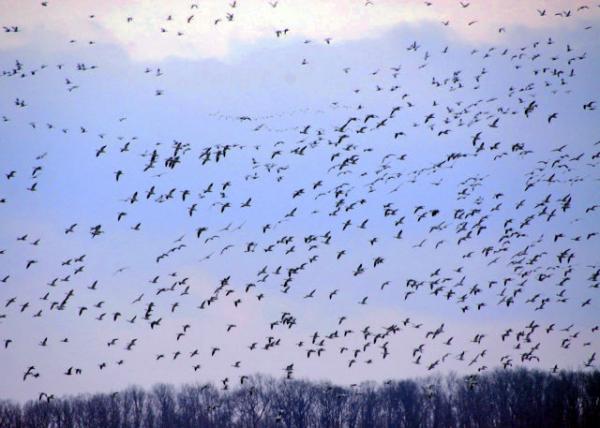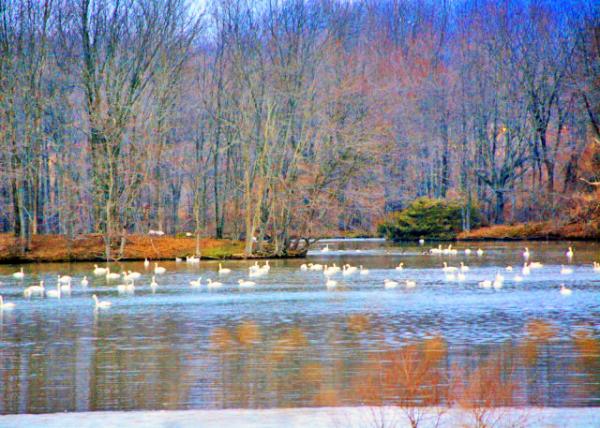2015-03-21

【Aiden in English】
Like humans, warm-blooded animals require warmth to survive. We wear winter coats to trap heat and turn on the heating at home during the prolonged, freaky weather in the Greater Philadelphia Area. For birds, warmth is just as critical because they lack the technology, science, and tools to generate it. The only remaining option would be to relocate to a place with a warmer climate. Snow geese are just one of the many vagrant birds that migrate when the cold comes, and they don’t enjoy brutal summer heat either. So, in the frosty air of North America, all of the snow geese fly south to the coastal marshland in Mexico. Once spring arrives, they return to the north, where temperatures warm up on their feeding grounds in the Arctic tundra. On every trip at this time of the year, stops are made across the farm fields on Triassic Lowlands along the Appalachian Mountains before dark, since geese don’t have perfect night vision. I don’t know about you, but I like to see where I’m going. One of these stops is located in the Middle Creek Wildlife Management Area of PA, but this artificial “creek” is more accurately described as a lake. On Monday, about 110,000 white feather creatures were in total. As the days dragged on, the numbers dwindled. By Thursday, 65,000 birds slept there. Today was Saturday, and yesterday, it snowed again—a lot on the Equinox. The temperature wasn’t so pleasant that the creek was frozen over. The snow geese didn’t like the unpredictable incident, so only about 16,000 gathered there. Tens of thousands sounded dramatic, but some decided to leave for the next stop in the Finger Lakes of New York during the day. As the night fell, only a portion of 16,000 roosted in the open water while the southerly winds were dying down. Mom parked the car on the side of a trail, and everyone began going in the direction to catch up with the migration in the area. We joined a steady flow of twists, walking down a single, long, blacktop-paved path. Grandma stayed behind since she had trouble jogging, so we hit the road. Without Grandma, Mom and I quickly cranked up the pace, surpassing other tourists. The bird honks became audible around a bend, and we sprinted down the winding passageway. When I turned another corner, the trod stretched forward, and in the distance sat a pavilion the size of my hand. By then, the honks got somewhat obvious, but it wasn’t until Mom and I figured out the proper location and the real culprits. These noises weren’t those of geese, but of tundra swans. The tundra swans appeared as large, graceful birds with white plumage, floating in clumps and swimming around, but cautiously keeping their distance from the ice in the waterfowl propagation area. Because the tourists had to watch from what seemed like a light year away, the tundra swans’ features weren’t exactly considered “high-quality HD.” All I could say, other than their elegant necks and charming wings, was a spot of pure white. The tundra swans kept honking as if annoyed by having an audience flashing bright lights from these things up to our faces (cameras). We walked the remaining distance once Mom had taken her photos. Not too long after, we arrived at the pavilion, where no one was sitting and everyone was standing to see the snow geese. Grabbing a seat wasn’t going to make anyone make too much sound. The area next to the pavilion was a mob, with people packed tightly together. I’d estimate that about a hundred people were there, plus another fifty or so, if the slow, lazy, and late tourists who consistently take their time getting to a destination are included. This creek wasn’t just about the snow geese. I noticed it once Mom had forced an opening between the crowds to the front. I didn’t know how she did it, but we emerged unscathed. On one side were the white specks of snow geese in the Middle Creek Wildlife Management Area. I recognized them from an alone duet on the road. They were just like regular geese, except that they were white. This made them look almost angelic. Almost, because I’m pretty sure angels don’t quack at everything. On the other side was a large group of dark Canadian geese, nearly as many as the snow geese. A few were circling the area, looking for a spot to land, while the snow geese clumped together as a black shimmering quacking shape. Those that circled above them were like planes waiting to receive a docking gate from the control tower. They flew around repeatedly, and each time, the circuit was complete. A few moved losers and eventually found a spot. Mom finished capturing much quicker than I thought. So we were walking back down the same long path again. A flurry of quacks and honks erupted from behind us. A swirling black mass of snow geese exploded from the creek, writhing and twisting, almost as if all those birds had morphed into one enormous, hideous creature. The creature swerved and looped in a wide circle, as if showcasing its power and abilities. This was how they migrated, however. How do they travel so far when moving so erratically? The black mass twirled once again and then flew off. Moments later, the sky was filled with white, honking snow geese. These geese gathered like the Canadians, flying in loops, spins, and dives. The birds kept coming, white specks darting into the distance. They resembled a snake, except that this snake had a long, white body and could honk. Considering the sheer size of such a migration, sixteen thousand is a reasonable number in this position. Nature is full of mystery. First, I want to know how the snow geese fly in that formation, if you even call it a formation, because it’s cool. But the way of life is a mystery, and everything about it differs. I wonder what humans would do to get warm if we didn’t possess this technology. Would we migrate like the snow geese? 【红霞译】
恒温动物像人一样喜欢生活在气候温和的地方,今冬大费城“兄弟情谊”地区千里冰封万里雪飘,我们要么将自己裹得严严实实,要么把房温调得暖暖洋洋。而对于那些不懂科学技术无法因地制宜的鸟类生物来说,温度高低直接关系到生死存亡,南北迁徙自然成为它们顺应季节变化的唯一手段。
雪雁正是众多候鸟家族中的一员,既害怕天冷又讨厌天热,每当北方寒流来袭,它们挥师南下,直捣墨西哥沿海湿地避冷过冬;一旦天气回暖,它们集结北上,重新杀回北极苔原老家生儿育女。每年冬末春初之际,总有大批由南及北长途跋涉的雪雁要在天黑之前赶往阿巴拉契亚“河那边”山脉三叠纪盆地一带歇脚过夜,因为它们视力有限,无法摸黑飞行。不知你感觉如何,反正我喜欢看清前面要走的路。
宾夕法尼亚“山林”州中溪野生动物管理区便是雪雁北上迁徙路线上若干驿站之一,这个人工开凿的“河溪”俨若一个大湖,本周一吸引了差不多11万只雪雁前来驻足,但随着时间推移,数量急剧骤减,到周四为止已降至65,000只。今天星期六,昨个这儿又惨遭大雪洗礼,而且恰值春分当日,气温尚未回升,溪面依然结冰上冻。显然,这种突如其来的天气变化令雪雁无所适从,结果仅剩大约16,000只仍在附近徘徊,成千上万乍听起来好像不少,但有些已在白天离开了这里,继续朝下一站纽约州的五指湖方向前进,这么一来,当夜幕降临偏南风极度减弱的时候,只有其中一部分雪雁乐意降落在没有积雪覆盖的水面上。
妈妈将车停靠路边,随即加入到观赏雪雁迁徙的人群行列之中。中溪野生动物管理区内仅有一条弯弯曲曲的柏油马路,我们随大流前进,外婆因为腿脚不适而行走吃力,所以只好留守原地。既然外婆不能加盟同行,我和妈妈立刻大步流星,把其他游人远远地抛在身后。
转弯处频传鸟叫声,我们甩开步伐加速往鸟叫的地方冲去;等拐上另一条小路,眼前出现了一间小亭子,亭子本身不大,恐怕跟我脑袋差不多。正在这时,鸟叫声越来越响,我们好不容易才搞清楚鸟叫的方位,并确认是什么鸟在引吭高歌,原来这叫声不是雪雁发出来的,而是小天鹅。小天鹅看上去个头挺高,姿态优雅飘逸,羽毛洁白如玉,喜欢成群结队在水禽繁殖区内游来游去,并谨慎地躲让水面上浮动的冰块。因为我们只能从貌似光年以远的地方观赏小天鹅靓丽的倩影,所以并不能真正看清它们到底长什么样,我觉得除了颀长的脖颈和漂亮的翅膀之外,其清爽的羽毛给人留下深刻印象。小天鹅扯开喉咙仰天长啸,不知是不是因为我们早已见怪不怪的闪光灯冲着它们闪个不停而惹恼了这些家伙。等妈妈结束拍照,我们继续朝目的地走去,不久便来到小亭子跟前。亭子里面没有一个人坐着,大家全都站着等候雪雁到来,坐在凳子上确实对观景一点用也没有;亭子外面人山人海,估计一百到一百五十人左右,还要加上那些踱方步迈八字既不着急也不着慌慢慢腾腾朝这边开拔的游客。我发现来中溪观赏雪雁必须擅长在里三层外三层的人群中自如穿行,不知妈妈有何绝招,总之,我们自始自终安然无恙。
中溪野生动物管理区的一侧是白得透亮的雪雁,路边还有一对掉了队的伴侣,它们除了白羽毛之外,跟普通飞鹅没有多大区别,不过正因为浑身洁白,倒真像天使一般,但再像毕竟不是,世上哪有天使对什么都叫个不停呀。
中溪野生动物管理区的另一侧是当地深色的加拿大黑雁,数量不亚于雪雁,它们在空中盘旋,四处寻找落脚的地方;乌央央的雪雁席卷残云,凌驾于加拿大黑雁之上,宛若准备降落的飞机正焦急地听候机场指挥中心通知停靠站台。它们飞呀转呀,绕着绕着就绕成一圈,偶尔也有几只掉队,但最终都能知途迷返,妈妈见机快速按下快门。转眼功夫,我们又踏上来时走过的曲长小路,身后接连传来加拿大黑雁和雪雁嘎嘎嘟嘟的喧闹声,此时暮色苍茫,仍有大批雪雁依然翩翩起舞自由翱翔,在溪面上空好像形成一个超级魔兽,魔兽狂扭着庞大的身躯,极力彰显其气势磅礴的威严和无所不及的力量,这正反映出雪雁迁徙的决心。我真弄不明白这些弱不经风的生物竟然无畏远征辛劳,一路过来还这么欢蹦乱跳,欲与土生土长的加拿大黑雁比试兜圈翻转俯冲等高空技巧,中溪如此多娇,引无数英雄豪杰竞折腰。更有甚者,前面一拨先导队伍刚走,后面一拨志愿部队接上,一拨接一拨,宛若一条白色巨蛇,只不过这条巨蛇不但身长色白,而且还会叫唤。纵观浩浩荡荡迁徙大军,其实由一万六千雪雁组成如此气宇轩昂的巨蛇相当可观。 自然界奥秘无穷。首先,我想知道雪雁如何列队飞行,如果可以用列队一词来形容空中这种动态形状,因为它实在太酷;其次,生活本身神奇无限,每件事情都各不相同。我禁不住设想,假如人类并未掌握取暖技术,那么后果将会怎样,难道也像雪雁迁徙一样游走天下吗?
Today in History(历史上的今天): 2015: Margaret Kuo's Dragon's Lair(郭夫人龙园) 2015: Xulan Zheng Benediction Concert(郑绪岚音乐见证会)
2010: 练琴的时候(When Playing Piano)  After School (放学 03-20-2015) After School (放学 03-20-2015)
 Snow Blanket after 5.6-In-Snow Snow Blanket after 5.6-In-Snow
(5.6英寸/0.5米大雪留下的白毯)  Middle Creek Wildlife Management Area Middle Creek Wildlife Management Area
(中溪野生动物管理区 03-21-2015)  Flocks of Snow Geese (大群雪雁 03-21-2015) Flocks of Snow Geese (大群雪雁 03-21-2015)
 Snow Goose Spring Migration from Mexico to Canada in the Spring Snow Goose Spring Migration from Mexico to Canada in the Spring
(雪雁春季从墨西哥迁徙至加拿大)  Fly High (展翅高飞) Fly High (展翅高飞)
 Snow Geese, w/ Black Wingtips, Orange Legs, & a Dark Line across the Pink Bills Snow Geese, w/ Black Wingtips, Orange Legs, & a Dark Line across the Pink Bills
(雪雁·翼尖黑色,腿橙色,喙粉红色并带黑条纹)  Tundra Swans (苔原天鹅) Tundra Swans (苔原天鹅)
 Tundra Swans, the Whistling Swans Tundra Swans, the Whistling Swans
(苔原天鹅·吹口哨的天鹅) Crosslinks(相关博文):
USA(出游美国)
6th Grade(初中一年级) |
